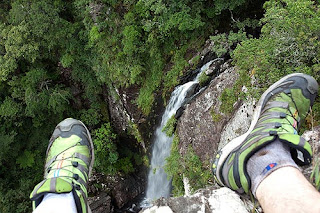quarta-feira, 16 de fevereiro de 2011
Você já pensou por que as pessoas se impressionam com os penhascos?
Why Do People Always Overestimate Slope?
"Holy Crap" is a very common phrase among mountain hikers when confronted by an intimidating slope. After plodding along at a nice five degree incline, a sudden rise in elevation can seem like either a daunting task or an irresistible challenge. I personally like sharp inclines because it means you can get more of the climb out of the way in quicker time. But sometimes that intimidating slope is not quite what it seems. According to a new study in the journal, Psychological Science, people routinely overestimate slope, whether they stand from the top or bottom. Our brains are hardwired to believe the incline is worse than it actually is.
It was previously believed that the reason for this was mankind's primeval fear of falling or an overwhelming sense of fatigue. Our minds perceive large hills as difficult and our thinking is therefore clouded by the potential physical exertion required and a sense of danger.
However, new research from Dennis Shaffer and Mariagrace Flint of the Ohio State University has found a contradiction to this common belief by looking at how people perceive the angle of stairs versus escalators. "We found that people tend to overestimate a slant even when they are looking at an escalator, and climbing or descending it would require practically no effort at all," Shaffer said.
The researchers surveyed 200 people, half from the top of an escalator and half from the bottom. Another 200 people were similarly surveyed at a staircase. The subjects consistently overestimated the angle of the slope by 18-19 degrees regardless of their location or whether they were at the stairs or escalator.
In reality, the stairs were set at 25 degrees, but people guessed they were 44 degrees. The escalator was really 30 degrees, but people guessed 48 degrees. The estimates were practically identical, even though the escalators require no physical effort. Therefore, our perceived avoidance of physical exertion or danger does not have as strong an influence as previously believed.
The researchers believe our perception is skewed due to the angle of our gaze. "If people believe they are looking more downward towards the bottom of the hill, and the hill looks perpendicular to their line of sight from there, the hill could look steeper to them," Shaffer said. "But this hasn't been tested — we’re working on that next."
Other research has shown that people think a hill is less steep when viewed from the edge, and more steep when they move back. From the bottom of the hill, our overestimates of slope are greater when viewed from farther away rather than up close. Shaffer believes our constant misperceptions of slope can be eliminated by learning. For example, roofers, who make their living on a slope, always seem to be more accurate with their estimations.
Link to published article: http://pss.sagepub.com/content/22/2/209.full
Fonte: Environmental News Network
Assinar:
Postar comentários (Atom)






















Por causa da visão a prumo, assusta, acho...
ResponderExcluir